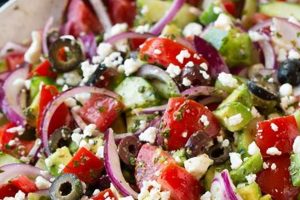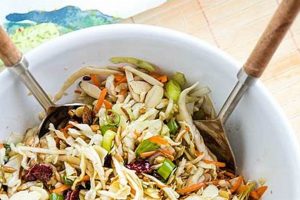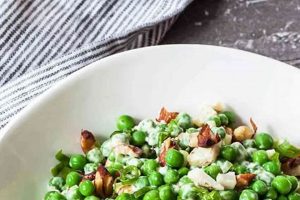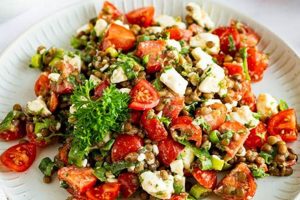A vibrant culinary creation featuring grilled or pan-seared beef, often flank or skirt steak, sliced and served atop a bed of fresh greens. This dish is distinguished by its namesake, a bright, herbaceous sauce originating in Argentina, typically composed of finely chopped parsley, oregano, garlic, red wine vinegar, and olive oil. Variations may incorporate other ingredients such as cilantro, red pepper flakes, or lemon juice.
This combination offers a balanced and flavorful meal. The steak provides a substantial source of protein and iron, while the salad contributes essential vitamins and fiber. The chimichurri sauce, with its zesty acidity and fresh herbs, not only complements the richness of the beef but also offers potential antioxidant benefits. This dish embodies a harmonious blend of South American flavors, adaptable to various palates and dietary preferences.
The following sections will delve deeper into optimal steak selection and preparation, techniques for crafting an authentic chimichurri sauce, and creative salad combinations to elevate this dish to its fullest potential.
Tips for an Exceptional Chimichurri Steak Salad
Achieving a truly remarkable dish requires attention to detail throughout the preparation process. These tips offer guidance for optimizing each element, from steak selection to sauce consistency, ensuring a flavorful and satisfying culinary experience.
Tip 1: Steak Selection: Opt for flavorful cuts such as flank or skirt steak. These cuts benefit from marinating and high-heat cooking, resulting in a tender and juicy final product.
Tip 2: Marinating the Steak: While not strictly traditional, a brief marinade can enhance the steak’s flavor. A simple combination of olive oil, garlic, and a touch of red wine vinegar can suffice.
Tip 3: Chimichurri Freshness: Utilize fresh herbs for the chimichurri. Dried herbs lack the vibrancy and aromatic intensity crucial for this sauce. Finely chopping the herbs is essential for optimal texture and flavor release.
Tip 4: Sauce Consistency: The chimichurri should be a loose, pourable sauce, not a paste. Adjust the olive oil quantity to achieve the desired consistency.
Tip 5: Balancing Flavors: Taste and adjust the chimichurri seasoning. Balance the acidity, saltiness, and herbaceous notes to complement the steak and salad components.
Tip 6: Salad Green Selection: Choose robust greens that can withstand the weight of the steak and the boldness of the chimichurri. Arugula, romaine, or watercress are excellent choices.
Tip 7: Grilling Technique: Employ high heat when grilling the steak to achieve a flavorful char while maintaining a tender interior. Allow the steak to rest before slicing to retain its juices.
Tip 8: Assembly and Serving: Slice the steak thinly against the grain and arrange it atop the dressed salad greens. Drizzle additional chimichurri over the steak just before serving.
By following these guidelines, one can ensure a balanced and flavorful experience, highlighting the vibrant interplay between the steak, the chimichurri sauce, and the fresh salad components.
These techniques contribute to a cohesive and satisfying meal that showcases the essence of this South American classic.
1. Fresh Chimichurri
Fresh chimichurri forms the heart and soul of a chimichurri steak salad recipe. This vibrant, uncooked sauce, originating in Argentina, delivers a potent herbal punch that elevates the dish beyond simply grilled steak and salad. Its freshness is paramount, as it provides the defining characteristic of this culinary creation.
- Herb Selection and Quality
The foundation of fresh chimichurri lies in the selection of high-quality, fresh herbs. Parsley and oregano are traditional and essential, offering distinct aromatic profiles. Cilantro can be incorporated for a brighter, more citrusy note. Using dried herbs significantly diminishes the vibrancy and overall impact of the sauce. Fresh herbs, finely chopped, release their essential oils, contributing significantly to the final flavor profile.
- Acidity and Balance
Red wine vinegar provides the necessary acidity, cutting through the richness of the steak and the oil in the sauce. The balance between the herbaceous notes, the acidity, and the subtle heat from optional red pepper flakes is critical. Lemon juice can be used as an alternative or in conjunction with red wine vinegar, adding a brighter citrus element. This acidic component balances the richness of the steak and the herbaceousness of the other ingredients.
- Garlic and Aromatics
Garlic, a key aromatic, contributes pungency and depth. The quantity can be adjusted to preference. Other aromatics, such as finely diced shallot or red onion, can add complexity. These elements infuse the sauce with a savory depth, enhancing its overall impact.
- Oil and Emulsification
Olive oil acts as a carrier for the flavors, binding the ingredients together. The quality of the olive oil directly impacts the final taste. The chimichurri should have a slightly emulsified texture, coating the herbs and other ingredients without being overly oily. This emulsification ensures even distribution of flavor across the salad.
The interplay of these fresh components results in a chimichurri sauce that is both vibrant and balanced. This freshness is crucial, as it defines the very essence of the chimichurri steak salad recipe, elevating it from a simple steak salad to a nuanced and flavorful culinary experience. The bright, herbaceous notes of the chimichurri, paired with the richness of the grilled steak and the crispness of the salad greens, create a harmonious and satisfying dish.
2. Quality Steak
Steak selection significantly influences the overall success of a chimichurri steak salad recipe. While the chimichurri sauce provides a vibrant and herbaceous counterpoint, the steak itself remains a central component, contributing essential protein and textural complexity. Choosing the right cut and understanding its characteristics are crucial for achieving a balanced and satisfying meal.
- Cut Selection
Selecting the appropriate cut is paramount. Flank or skirt steak, favored for their robust flavor and relatively quick cooking time, are ideal choices. These cuts, derived from the abdominal muscles of the cow, possess a rich, beefy flavor that pairs well with the bright acidity of the chimichurri. Other cuts, such as hanger or flat iron steak, can also be utilized, though their distinct characteristics might require adjustments to cooking times and temperatures.
- Marbling and Tenderness
Marbling, the intramuscular fat visible as thin white lines within the meat, contributes significantly to both flavor and tenderness. While leaner cuts can be used, a moderate amount of marbling ensures a more succulent and flavorful result, especially given the high-heat cooking methods often employed for this recipe. The rendered fat enhances the steak’s richness, complementing the chimichurri.
- Thickness and Cooking Time
Steak thickness directly impacts cooking time. A consistent thickness ensures even cooking, preventing overcooked exteriors and undercooked interiors. Thinner cuts, typically preferred for this recipe, cook quickly, allowing for a flavorful char while maintaining a tender interior. Adjusting cooking time based on thickness is essential for achieving the desired level of doneness.
- Sourcing and Freshness
Sourcing high-quality, fresh steak from a reputable butcher or market ensures optimal flavor and texture. Freshness indicators, such as a bright red color and a lack of off-putting odors, are important considerations. Proper storage, including refrigeration at appropriate temperatures, maintains the steak’s quality until preparation.
Careful consideration of these factors ensures a steak that complements the other elements of the chimichurri steak salad recipe. The interplay between the flavorful, properly cooked steak, the vibrant chimichurri sauce, and the fresh salad components creates a harmonious and satisfying culinary experience. A quality steak elevates the dish, transforming it from a simple salad into a memorable meal.
3. Vibrant Greens
The selection of greens plays a crucial role in a successful chimichurri steak salad recipe. They provide a refreshing counterpoint to the richness of the steak and the boldness of the chimichurri sauce. Beyond mere visual appeal, the greens contribute texture, flavor, and nutritional value, elevating the dish from a simple protein-and-sauce combination to a balanced and satisfying meal.
- Flavor Compatibility
The chosen greens should complement, not clash with, the dominant flavors of the steak and chimichurri. Arugula, with its peppery bite, offers a robust counterpoint, while watercress provides a slightly bitter, peppery edge. Milder greens like romaine or butter lettuce offer a more neutral backdrop, allowing the other flavors to take center stage. Spinach, with its slightly earthy notes, provides another viable option. Matching the intensity of the greens to the other components ensures a harmonious flavor profile.
- Textural Contrast
The texture of the greens contributes significantly to the overall sensory experience. Crisp, sturdy greens like romaine or radicchio offer a satisfying crunch, contrasting with the tender steak. More delicate greens like baby spinach or butter lettuce provide a softer texture. The interplay of textures enhances the enjoyment of the dish, preventing a monotonous mouthfeel.
- Nutritional Value
Beyond flavor and texture, greens contribute valuable nutrients. Dark leafy greens like spinach and arugula are rich in vitamins A and C, as well as minerals like iron and potassium. Incorporating nutrient-rich greens enhances the overall healthfulness of the meal, adding another layer of value to the dish.
- Visual Appeal
The visual presentation of the salad plays a role in its overall appeal. A mix of colors and textures can create a more visually engaging dish. Incorporating elements like red onion, bell peppers, or cherry tomatoes adds pops of color, while different types of greens introduce textural variation. A visually appealing salad enhances the dining experience, stimulating appetite and enjoyment.
The careful selection of vibrant greens elevates the chimichurri steak salad recipe beyond a simple combination of ingredients. The chosen greens contribute not only to the visual appeal but also to the overall flavor, texture, and nutritional balance. By considering these aspects, one can create a dish that is both satisfying and visually appealing, showcasing the harmonious interplay of flavors and textures.
4. Proper Grilling
Proper grilling technique is essential for achieving a perfectly cooked steak, a cornerstone of the chimichurri steak salad recipe. The grilling process significantly influences the steak’s final flavor, texture, and overall appeal, impacting the dish’s overall success. Understanding the nuances of heat, timing, and technique ensures a steak that complements the vibrant chimichurri sauce and fresh salad components.
- High Heat Searing
High heat is crucial for creating a flavorful crust on the steak’s exterior, known as the Maillard reaction. This reaction browns the surface, developing complex flavors and aromas. A hot grill sears the steak quickly, sealing in juices and creating a desirable textural contrast between the crisp exterior and the tender interior. This sear enhances the steak’s inherent richness, complementing the chimichurri’s bright, herbaceous notes.
- Controlled Cooking Temperature
Maintaining a consistent cooking temperature throughout the grilling process ensures even cooking. Monitoring the grill’s temperature and adjusting accordingly prevents overcooked exteriors and undercooked interiors. This control allows for achieving the desired level of doneness, whether rare, medium-rare, or medium, crucial for maximizing the steak’s tenderness and flavor.
- Resting Period
Allowing the steak to rest after grilling is essential for retaining its juices. During the resting period, the muscle fibers relax, reabsorbing juices that were drawn to the surface during cooking. This process results in a more tender and flavorful steak. Cutting into the steak immediately after grilling releases these juices, resulting in a drier, less palatable final product.
- Slicing Technique
Slicing the steak against the grain, once rested, shortens the muscle fibers, further enhancing tenderness. Thinly sliced steak provides a pleasant texture, making it easier to eat and ensuring that each bite incorporates both the flavorful crust and the tender interior. Proper slicing technique maximizes the enjoyment of the steak, contributing significantly to the overall dining experience.
Mastering these grilling techniques elevates the chimichurri steak salad from a simple combination of ingredients to a carefully orchestrated culinary experience. The properly grilled steak, with its flavorful crust and tender interior, provides a substantial and satisfying foundation, complementing the bright chimichurri and fresh greens. The interplay of flavors and textures creates a harmonious and memorable dish.
5. Balanced Flavors
Balanced flavors are essential for a successful chimichurri steak salad recipe. The dish thrives on the interplay of contrasting yet complementary tastes, creating a harmonious culinary experience. Understanding this interplay and how each component contributes to the overall balance is crucial for achieving a truly satisfying result.
- Acidity
The acidity of the chimichurri, primarily derived from red wine vinegar or lemon juice, cuts through the richness of the steak and the oil in the sauce. This brightness prevents the dish from feeling heavy and balances the savory elements. The level of acidity should be sufficient to provide a refreshing contrast but not so overwhelming as to overpower the other flavors.
- Herbaceousness
The fresh herbs in the chimichurriparsley, oregano, and sometimes cilantroprovide a vibrant, herbaceous counterpoint to the richness of the steak. These herbal notes add complexity and freshness, preventing the dish from being one-dimensional. The balance of these herbs is key, ensuring that no single herb dominates the flavor profile.
- Richness
The steak itself contributes richness and umami. The inherent fattiness of the chosen cut, enhanced by proper grilling techniques, provides a savory depth that complements the brighter elements of the dish. This richness is essential, acting as a grounding element against which the other flavors play.
- Saltiness
Salt enhances the flavors of all the components. Proper seasoning of both the steak and the chimichurri is crucial, bringing out the inherent flavors of each ingredient. The level of saltiness should be carefully calibrated to enhance, not overpower, the other taste elements. A delicate balance ensures that the salt complements the dish without making it overly salty.
The careful balancing of these flavorsacidity, herbaceousness, richness, and saltinesscreates a dynamic and harmonious flavor profile. Each element plays a crucial role, contributing to a complex and nuanced culinary experience. A well-balanced chimichurri steak salad is not merely a sum of its parts but a carefully orchestrated interplay of contrasting yet complementary tastes, resulting in a truly satisfying and memorable dish.
6. Thoughtful Assembly
Thoughtful assembly is the final, crucial step in creating a truly exceptional chimichurri steak salad. It moves beyond simply combining ingredients and elevates the dish to a visually appealing and palate-pleasing experience. Consideration of slicing techniques, plating arrangements, and final drizzling of the chimichurri sauce significantly impacts the overall enjoyment of this vibrant culinary creation.
- Steak Slicing and Arrangement
Slicing the steak against the grain, after a proper resting period, is paramount. This technique shortens the muscle fibers, maximizing tenderness. Thin slices, evenly distributed across the bed of greens, ensure manageable bites and an aesthetically pleasing presentation. Overlapping slices slightly creates visual interest and prevents the steak from appearing scattered or haphazard.
- Salad Green Distribution and Base
Creating a bed of evenly distributed salad greens provides a foundation for the steak and ensures that each bite incorporates a balance of flavors and textures. The greens should be tossed lightly with a small amount of olive oil and perhaps a touch of the chimichurri sauce to prevent them from being dry. This pre-dressing also helps the greens adhere to the plate, creating a more cohesive presentation.
- Chimichurri Drizzling and Distribution
The final drizzling of chimichurri sauce requires a delicate touch. Too much sauce can overwhelm the other flavors and make the salad soggy, while too little leaves the dish lacking its signature vibrancy. A gentle drizzle over the sliced steak and perhaps a light coating over the greens achieves the desired balance, ensuring that each bite is infused with the sauce’s herbaceous brightness.
- Garnish and Final Touches
A simple garnish can elevate the visual appeal and add a final layer of flavor. A sprinkle of flaky sea salt enhances the savory notes, while a scattering of freshly cracked black pepper adds a touch of spice. A few extra sprigs of fresh parsley or oregano provide a visual reminder of the chimichurri’s key components. These final touches, while seemingly minor, contribute significantly to the overall presentation and sensory experience.
Thoughtful assembly transforms the chimichurri steak salad from a collection of ingredients into a cohesive and visually appealing culinary creation. The careful consideration of slicing, plating, and final touches elevates the dish, maximizing both its aesthetic appeal and its palate-pleasing potential. This attention to detail ensures a harmonious balance of flavors, textures, and visual elements, culminating in a truly satisfying dining experience.
Frequently Asked Questions
This section addresses common inquiries regarding the preparation and enjoyment of chimichurri steak salad, offering clarity and guidance for a successful culinary experience.
Question 1: Can chimichurri sauce be made ahead of time?
Chimichurri sauce benefits from being prepared in advance, allowing the flavors to meld. Ideally, prepare it at least two hours before serving, or even a day ahead, storing it in an airtight container in the refrigerator. This allows the flavors of the herbs and garlic to infuse the oil, resulting in a more robust and balanced sauce.
Question 2: What cuts of beef are suitable alternatives to flank or skirt steak?
Hanger steak, flat iron steak, or even sirloin can be suitable substitutes for flank or skirt steak. Adjust cooking times accordingly to account for variations in thickness and desired doneness. These alternatives offer similar flavor profiles and textures, ensuring a satisfying result.
Question 3: How can the spiciness of the chimichurri sauce be adjusted?
The amount of red pepper flakes incorporated into the chimichurri directly influences its spiciness. Omit them entirely for a milder sauce or increase the quantity for a more pronounced heat. Freshly chopped jalapeos or other chili peppers can also be added for a different dimension of heat.
Question 4: What salad greens pair well with the robust flavors of chimichurri and steak?
Robust greens like arugula, watercress, or radicchio offer a pleasant contrast to the richness of the steak and the boldness of the chimichurri. Milder greens like romaine or butter lettuce can also be used, providing a more neutral base. The choice of greens depends on individual preference and the desired balance of flavors.
Question 5: Can the chimichurri steak salad be adapted for dietary restrictions?
This dish can be easily adapted for various dietary needs. For gluten-free diets, ensure all ingredients, especially any added condiments, are gluten-free. Vegetarian or vegan adaptations can substitute grilled portobello mushrooms or halloumi cheese for the steak. These substitutions offer similar textural experiences while maintaining the core flavor profile of the dish.
Question 6: How should leftover chimichurri steak salad be stored?
Store leftover steak and salad components separately in airtight containers in the refrigerator. The chimichurri sauce can be stored separately as well. Consume leftovers within two to three days for optimal quality. Storing components separately prevents the salad from becoming soggy and maintains the integrity of each element.
Understanding these frequently asked questions ensures successful preparation and enjoyment of chimichurri steak salad. Attention to detail, from sauce preparation to steak selection and thoughtful assembly, elevates this dish, creating a satisfying culinary experience.
For further exploration of chimichurri steak salad, the following resources offer additional insights and variations.
Chimichurri Steak Salad Recipe
This exploration has highlighted the multifaceted nature of the chimichurri steak salad recipe. From the vibrant herbaceousness of the chimichurri sauce to the careful selection and grilling of the steak, each component contributes significantly to the overall culinary experience. The balance of flavors, the textural interplay, and the thoughtful assembly are crucial for achieving a harmonious and satisfying result. Understanding the nuances of each element, from the freshness of the herbs to the proper slicing technique for the steak, elevates this dish beyond a simple salad, transforming it into a carefully orchestrated symphony of flavors and textures.
The chimichurri steak salad recipe represents a culinary crossroads where South American tradition meets contemporary culinary innovation. Its adaptability allows for personal interpretations and adjustments while retaining its core essence. Further exploration of ingredient variations, grilling techniques, and complementary pairings offers a continuous path of culinary discovery, promising an evolving and enriching gastronomic journey.






